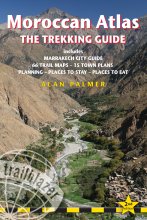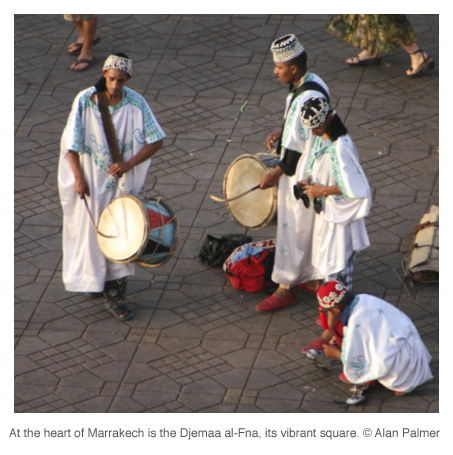Worth watching out for.
— John Cleare

Moroccan Atlas - the Trekking Guide
Excerpt:
Marrakech
Contents | Introduction | Minimum impact trekking | Planning your trip | Marrakech | Using this guide | Sample trek: Toubkal circular trek | Moroccan Atlas Trekking Routes
Fes and Rabat, Safrou, Salee and Mogador with Tetuan, Larache, Dar-el-Baida and the rest may have more trade, more art, more beauty, population, importance, industry, rank, faith, architecture, or what you will, but none of them enter into your soul as does this heap of ruins, this sandheap, desert town, metropolis of the fantastic world which stretches from its walls across the mountains through the oases of the Sahara. …
R B Cunninghame Graham, Mogreb-el-Acksa, 1898
Arriving in the imperial city of Marrakech is an almost overwhelming experience:the combined assault of sounds, smells and sights will set  your senses reeling. Djemaa al-Fna, the city’s central square and its cultural pulse, is where the assault is at its most intense. Snake-charmers, story-tellers, street dentists and Berber drummers compete for attention with frenzied enthusiasm. This almost non-stop display is not originally aimed at tourists; look at the crowds around the musicians and fortune-tellers and you will still see mostly Moroccans. Djemaa al-Fna is the single most important feature of the city. There is no other sight quite like it in the Arab world.
your senses reeling. Djemaa al-Fna, the city’s central square and its cultural pulse, is where the assault is at its most intense. Snake-charmers, story-tellers, street dentists and Berber drummers compete for attention with frenzied enthusiasm. This almost non-stop display is not originally aimed at tourists; look at the crowds around the musicians and fortune-tellers and you will still see mostly Moroccans. Djemaa al-Fna is the single most important feature of the city. There is no other sight quite like it in the Arab world.
Marrakech, the Red City, has another great draw: its low-rise sprawl of red-pink buildings which appear to have grown out of the ground in a moment of blossoming, then baked solid in the scorching African sun. It’s hard to see where one house stops and another starts. Indeed, the souks and narrow streets of the old Medina form a beguiling labyrinth. All this is framed by the peaks of the High Atlas which appear to curl around the city. In turn, the mountains are set against a consistently perfect deep blue sky. The effect is quite staggering.
The city is a mix of ancient and modern; in the east the walled Medina suggests time has made only limited progress. The streets, architecture and souks appear to have changed little over hundreds of years. Only television aerials, satellite dishes and the constant roar of taxis and scooters piloted by crazed locals hint that the third millennium has arrived. The west of Marrakech is the Ville Nouvelle, or new city, in which modern blocks of apartments and businesses were built during the years of the French Protectorate. But a combination of questionable construction and a faithful dedication to Marrakech’s universal colour scheme has left even the Ville Nouvelle looking strangely worn by the Saharan sands of time.
Marrakech is defined by a fascinating blend of Arab and Berber cultures; this is one reason why the city has become such an important centre for arts and crafts. As a fast-growing tourist destination, Marrakech has seen an influx of Western visitors who have to some extent diluted the city’s attitudes. So one might see a Muslim woman veiled in the traditional manner walking alongside a younger Moroccan girl dressed in jeans or even a short skirt. But this is still a deeply religious city. Calls to prayer resonate from the tops of mosques and Koutoubia, the 220ft-high minaret which dominates the city’s skyline, is closed to non-Muslims.
For trekkers, Marrakech is above all a sort of base camp. This is where you are most likely to start and finish your Moroccan Atlas trip. Here you will find supplies, advice, telephones, fax machines and the internet. More importantly, perhaps, Marrakech will be ready to welcome you back from the mountains with a warm shower, an extravagant dinner and a long, cold drink. That almost overwhelming assault on the senses with which the Marrakech Medina greets new visitors might cause some to run for cover. Yet travellers have nothing to fear from this colourful theatre: allow several days to explore an extraordinary city.
Latest tweets